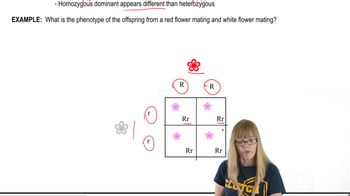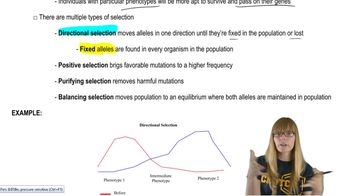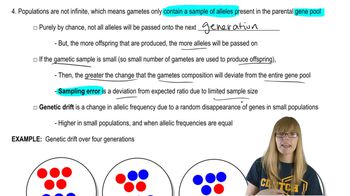Table of contents
- 1. Introduction to Genetics51m
- 2. Mendel's Laws of Inheritance3h 37m
- 3. Extensions to Mendelian Inheritance2h 41m
- 4. Genetic Mapping and Linkage2h 28m
- 5. Genetics of Bacteria and Viruses1h 21m
- 6. Chromosomal Variation1h 48m
- 7. DNA and Chromosome Structure56m
- 8. DNA Replication1h 10m
- 9. Mitosis and Meiosis1h 34m
- 10. Transcription1h 0m
- 11. Translation58m
- 12. Gene Regulation in Prokaryotes1h 19m
- 13. Gene Regulation in Eukaryotes44m
- 14. Genetic Control of Development44m
- 15. Genomes and Genomics1h 50m
- 16. Transposable Elements47m
- 17. Mutation, Repair, and Recombination1h 6m
- 18. Molecular Genetic Tools19m
- 19. Cancer Genetics29m
- 20. Quantitative Genetics1h 26m
- 21. Population Genetics50m
- 22. Evolutionary Genetics29m
21. Population Genetics
Allelic Frequency Changes
Problem 9a
Textbook Question
George Udny Yule was wrong in suggesting that an autosomal dominant trait like brachydactyly will increase in frequency in populations. Explain why Yule was incorrect.
 Verified step by step guidance
Verified step by step guidance1
Understand the concept of autosomal dominant traits: These are traits where only one copy of the dominant allele is needed for the trait to be expressed.
Consider the Hardy-Weinberg principle: This principle states that allele and genotype frequencies in a population will remain constant from generation to generation in the absence of other evolutionary influences.
Identify the factors that can change allele frequencies: These include mutation, selection, gene flow, genetic drift, and non-random mating.
Recognize that Yule's assumption ignores these factors: Yule assumed that the frequency of a dominant trait would naturally increase, but this ignores the balance of evolutionary forces that can maintain or even decrease allele frequencies.
Conclude that dominance does not equate to increased frequency: The dominance of an allele does not inherently lead to an increase in its frequency without selective advantage or other evolutionary pressures.
Recommended similar problem, with video answer:
 Verified Solution
Verified SolutionThis video solution was recommended by our tutors as helpful for the problem above
Video duration:
2mPlay a video:
Was this helpful?
Key Concepts
Here are the essential concepts you must grasp in order to answer the question correctly.
Autosomal Dominant Inheritance
Autosomal dominant inheritance refers to a pattern where only one copy of a mutated gene from an affected parent can cause the trait to manifest in offspring. This means that individuals with the trait have a 50% chance of passing it on to their children. However, the trait's frequency in a population can be influenced by factors such as fitness and reproductive success.
Recommended video:
Guided course

Variations on Dominance
Population Genetics
Population genetics studies the distribution and change in frequency of alleles within populations. Factors such as natural selection, genetic drift, and mutation can affect allele frequencies. In the case of brachydactyly, if the trait negatively impacts reproductive success, its frequency may not increase despite being autosomal dominant.
Recommended video:
Guided course

Descriptive Genetics
Fitness and Natural Selection
Fitness in genetics refers to an organism's ability to survive and reproduce in its environment. Natural selection can lead to a decrease in the frequency of traits that are disadvantageous for survival or reproduction. If brachydactyly reduces an individual's fitness, Yule's assumption that it would increase in frequency is flawed, as natural selection would likely counteract this increase.
Recommended video:
Guided course

Natural Selection

 5:58m
5:58mWatch next
Master Natural Selection with a bite sized video explanation from Kylia Goodner
Start learning



